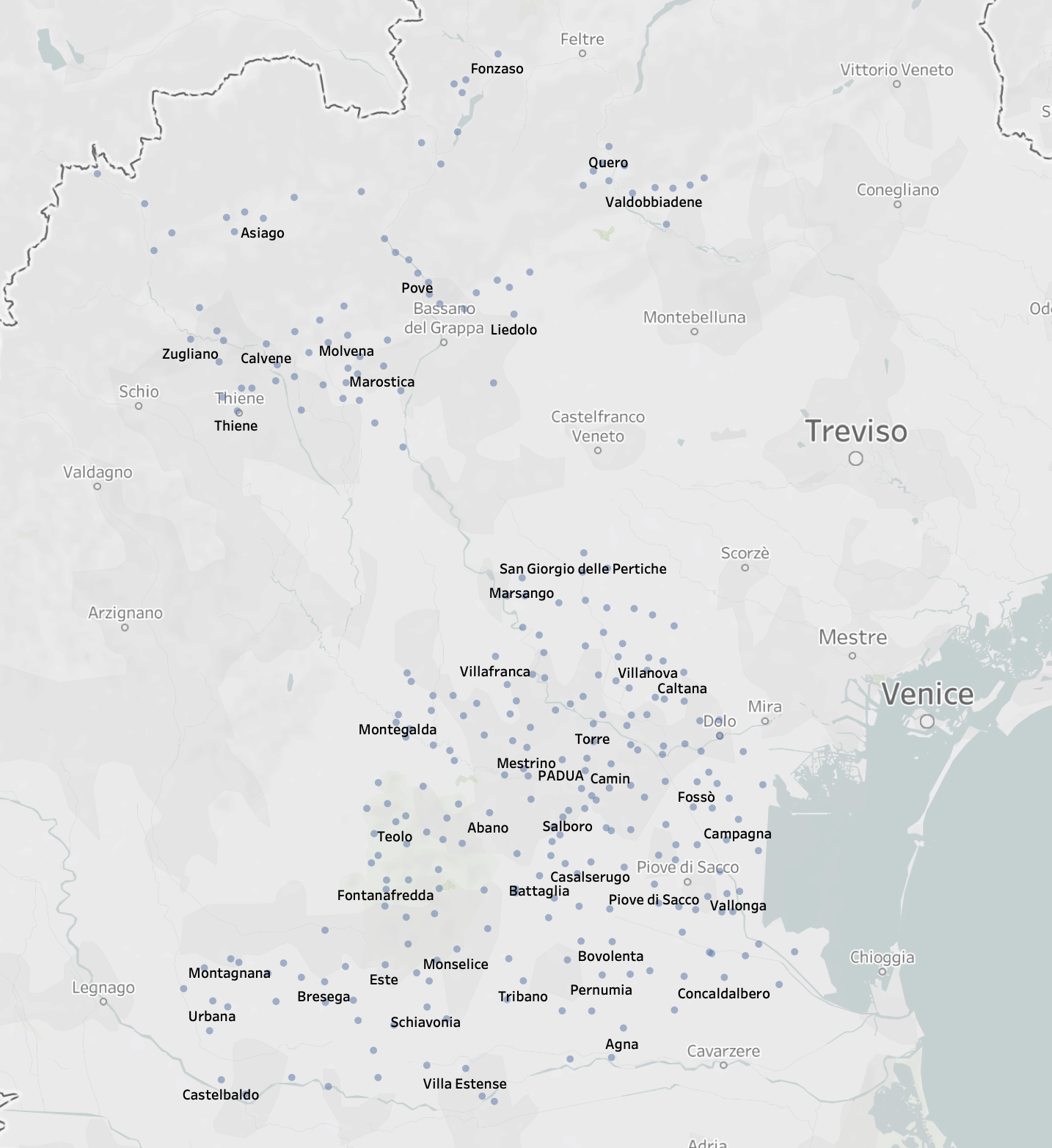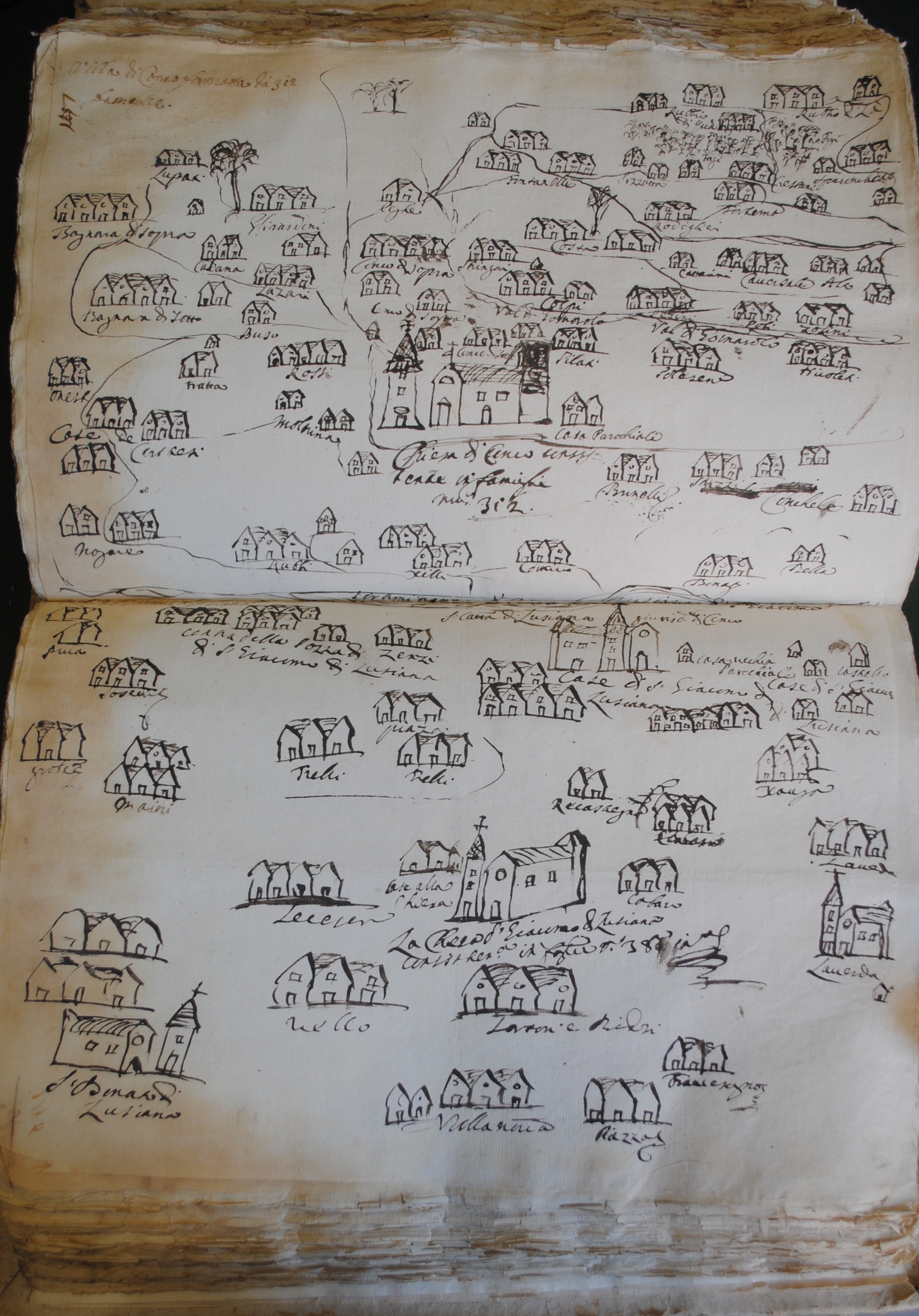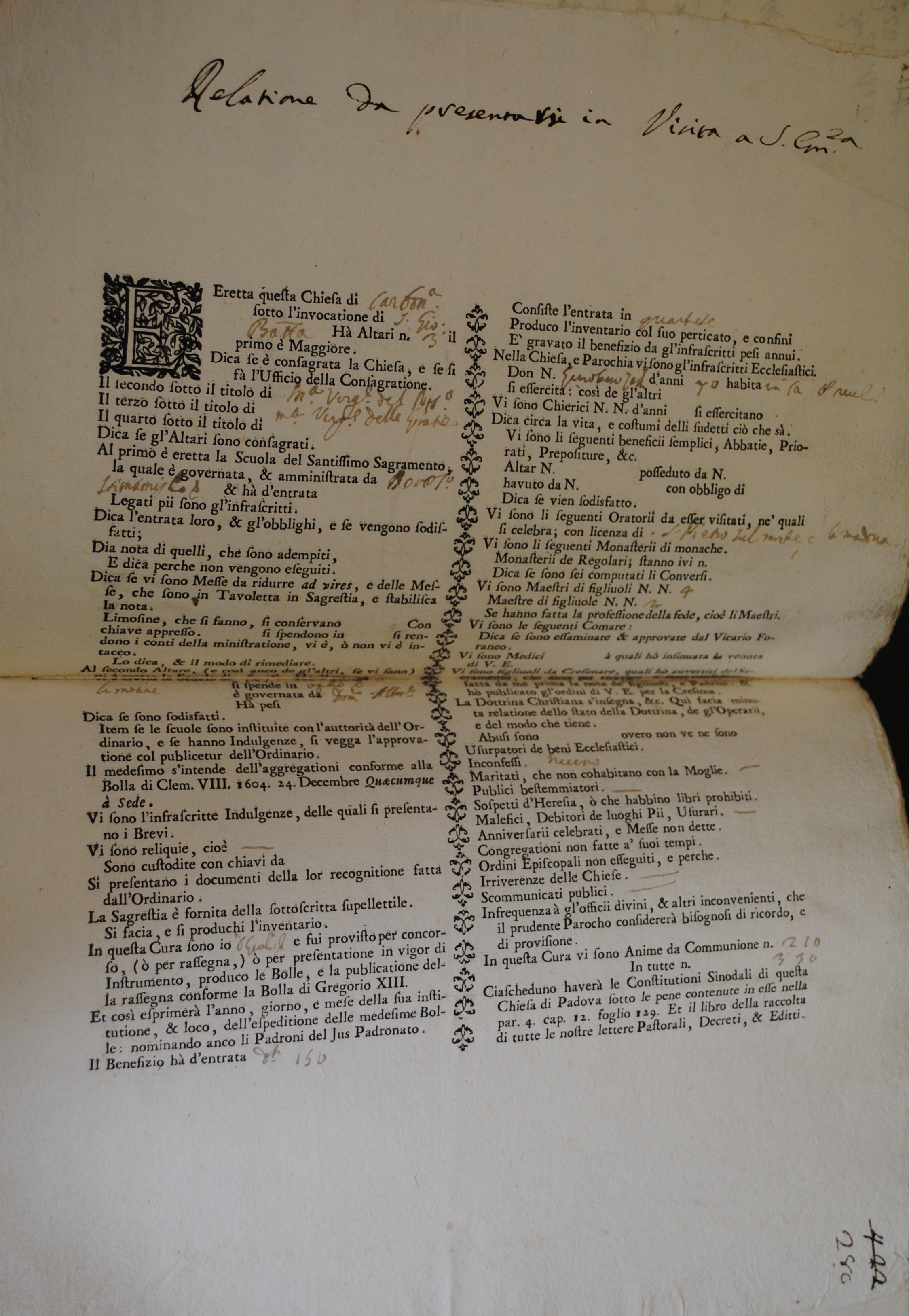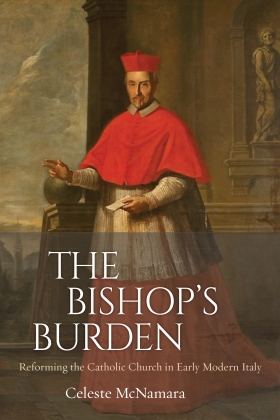Encountering the Parish in Seventeenth-Century Italy
From 1664-1697, Cardinal Bishop Gregorio Barbarigo (1625-1697) served the diocese of Padua. During his thirty-three-year tenure, he completed three pastoral visitations and began a fourth, trying to get to know and reform the more than 300 rural parishes under his jurisdiction. (See Figure 1) Unlike most reforming bishops, he not only undertook these visitations personally, but he devoted significant time to them, spending days in each village. In the process, he became acquainted with his diocese but also made himself visible and available to rural Catholics who might otherwise have never encountered a cleric of higher rank than their own parish priest.

Fig 1. Extra-urban Parishes and Vicarages in the Diocese of Padua. Celeste McNamara, 2020. Created using Tableau Desktop, version 2019.2. Seattle: Tableau Software, Inc., 2020.
Barbarigo took as his duty the full implementation of the Tridentine Decrees, a heady task for any person. He expanded his diocesan government and bureaucracy, restored and enlarged the capacity of his seminary, provided other educational opportunities for priests and laity alike, held diocesan synods, supported missionary efforts at home and abroad, and attempted to reform even the minute details of parish life. Although each of these tasks presented substantial challenges and required extraordinary dedication and labour, it was the final task of reforming his flock that most plagued him. On his deathbed, he found it difficult to be reassured by his successes, and instead feared judgment on the basis that he had not managed to stop every single one of the quarter of a million souls under his care from sinning.[1]
His pastoral visitations revealed a wide variety of problems, some easier to fix than others. Predictably, he found poorly outfitted and funded churches, uneducated priests and laypeople, conflicts between clergy and parishioners (often over tithing and confraternity alms or over the provision of services and sacraments), and even poor parochial assignments that required households to travel to inconvenient churches when a closer one was available (See Figure 2). Many of these problems could be fixed, or at least mitigated, and Barbarigo arrived prepared to find ways to better fund churches, provide casuistry exercises and catechism manuals, settle disputes via written decrees, admonish clergy to better perform their duties, and reassign houses to more convenient parishes. But he also found more dramatic and unusual problems, some of which he was far less prepared to handle.

Fig. 2. Manuscript Parish map, parishes of Conco and Lusiana. Visitationes 56, 1688, Archivio della Curia Vescovile di Padova.
When he arrived at an individual parish, he processed through town to the church, said mass, and visited the entire parish church and its surrounding structures. He closely inspected every part of the church property and reviewed the priest’s documents and relazione. Before his arrival, he sent a form to the priest for this document, asking for details about the church, including its finances, altars, and furnishings; the priests in residence and any local regular clergy; the catechism school, its teachers, and students; local doctors and midwives; and any problematic parishioners, including the unconfessed, non-cohabiting married couples, heretics, blasphemers, and other public sinners.[2] (See Figure 3) He spoke to all secular clergy in the parish, rather than just the parish priest, and usually asked to speak with prominent laymen, starting with confraternity leaders. If he found evidence of any problems, he might widen his interview list to include more laypeople; most other bishops never even asked the questions that might elicit such information.[3] Finally, he almost always set aside a few hours for an open audience with parishioners. He invited the laity to visit him in the church or parish house, where they could speak with him about their troubles and complaints.[4] In most parishes, the visit took two to three days, though in the largest towns he would stay up to two weeks. In most cases, the parish had minor problems, and if the community and priest were willing to cooperate, Barbarigo could solve them. But some parishes were deeply dysfunctional and demonstrated to Barbarigo just how far he had to go in order to reform his diocese completely.

Fig. 3. Relazione form, parish of Carbonara, Visitationes 65, 1696, Archivio della Curia Vescovile di Padova.
In some parishes, the laypeople were quick to complain about the quality of services they were receiving. In one village, laity lamented that their priest “recites the mass quickly with the greatest rapidity, chatting, taking tobacco, and in general [acts] with great irreverence, which causes great scandal among the people.”[5] In another village, the priest was supposedly “always drunk” while administering the sacraments.[6] Complaints about priests who could not be found, who left town for days, or who simply refused to say an early mass for farmers and travellers were also common.
Laypeople also complained about the morality of their clergy. In one larger town which had a collegiate chapter, the priests often gathered for an event akin to a pub crawl; they went from house to house with food and jugs of wine, getting progressively more inebriated as the day wore on.[7] In a small village, the sole priest was often “happy from wine,” and in this condition would abuse his parishioners, “calling this one or that one a sodomite, and other similar things, even when called to administer the sacraments.”[8] Another priest did not even need to lower his inhibitions with wine; he stood at the pulpit and called his parishioners “a herd of asses, sacks of lice, dirty peasants, and similar things” when they failed to fully pay their tithes.[9] Other priests chose to make love, not war, but this too could cause their parishioners to complain. In one village the priest was seen mooning over his sister-in-law. He was “curious of eye” in church, “made eyes” at her near the bell tower in the evenings, and generally made a fool of himself. His parishioners thought “it might be better for him to attend to his occupation as priest, and not pay court.”[10]
The complaints could go both ways, of course. Barbarigo interviewed priests about the laypeople just as he gave laypeople space to talk about their priests. In one particularly unruly parish, the priest bemoaned that his parishioners “played with arquebuses and pikes in the church[yard?], throwing their hats on the altars, making noise, laughing, joking, and swearing in church.”[11] Although the priest fulfilled all of his duties, “few come to Vespers, catechism classes, to accompany the dead, but [instead] they frequent the taverns armed, and often they have brawls and kill each other.”[12] Priests expressed frustration with parishioners who resisted paying their tithes, attending services respectfully, complying with the Tridentine Decrees’ regulations for marriage ceremonies, and attending or sending their children to catechism classes, or who persisted in various superstitions.
Although Barbarigo was willing to expend significant time and resources to fix not only the systemic weaknesses in his diocese but also the local minutiae, he found it impossible to fully succeed in either. Of course, complete reform was an unrealistic goal, and by many metrics he was a resounding success, demonstrated not least by his beatification in 1761 and canonization in 1960 as a model Tridentine reformer. But Barbarigo’s tireless and frustrating work in parochial reform is especially revealing of the impossibility of the task set to bishops by the Council of Trent. For centuries, rural parishes especially had been left largely to their own devices and allowed to chart their own paths. In some cases this led to functional communities that simply had somewhat strange practices, at least in the eyes of the Catholic hierarchy; in others, it led to deep dysfunction. Although the Council of Trent took seriously the need to ensure good priests served even the most remote parishes and that laypeople received a proper catechetical education, they failed to provide bishops with the resources and strategies needed to accomplish this, or even to ensure they had a manageable territory to cover. Barbarigo’s struggles, in spite of his dedication, resources, and skill as an administrator and reformer, demonstrate the deep systemic challenges of reforming the parish in early modern Europe.
[1] According to his friend Giuseppe Musocco, who was in the room, Barbarigo cried out “Oh me, Oh me, such fear! . . . I do not know what will become of me. . . Oh, how many sins, how many sins are on me? The sins of so many souls. What a great count! What a severe count! . . . Oh me, the Judge is a God, the Judge is a God, a God. Ah, nothing can console me.” (“Oimé, Oimé, quanto terrore! La ho mandato a chiamare mi aiuto perchè non so che sarà di me . . . O quanti peccati, quanti peccati sono sopra di me? I peccati di tante anime. Quel gran conto! Quel strettissimo conto! . . . Oimé, il Giudice è un Dio, il Giu-dice è un Dio, Dio. Ah! Che niente mi può consolare.”) Giuseppe Musocco, “Delle azioni e virtù di Gregorio Barbarigo cardinale e vescovo di Padova” (1698), fol. 260r–v, MS BP 609, BCP.
[2] See Figure 2 for a copy of this form, in this case filled in by a rather lazy priest (it was supposed to be copied out and expanded upon). The formula for the relazione has also been published in Liliana Billanovich Vitale, “Per uno studio delle visite pastorali del Barbarigo 1. Note introduttive alla prima visita (1664-1671),” Contributi alla storia della Chiesa padovana nell’età moderna e contemporanea 1 (1982): 65.
[3] Most episcopal inquisitions were fairly pro forma and short, given the visitation schedules and bishops’ interests. For more on the types of questions asked, see Peter Burke, “The Bishop’s Questions and the People’s Religion,” in The Historical Anthropology of Early Modern Italy (Cambridge: Cambridge University Press, 1987), 40–47.
[4] For a more detailed description of the visitation format, see Giuseppe Rocco, I luoghi di San Gregorio: strade e paesi nel itinerario pastorale del vescovo Barbarigo (Padua: Tipografia Antoniana, 1961), 79–80.
[5]“Si recita velocemente con somma prestezza, chiacolando, prendendo tabacco, et in somma con grande irreverenza, ch’apporta gran scandalo al popolo.” Inquisitiones, b. 85 (1668), fol. 207r, ACVP.
[6]“Lo ritrovano sempre inbriaco.” Inquisitiones, b. 85 (1668), fol. 321r, ACVP.
[7] Inquisitiones, b. 85 (1668), fol. 318r, ACVP.
[8]“Allegro dal vino…strappazzando questo e quello di razze buzerone, et cosi simili anco essendo chiamato per l’amministratione de sacramenti.” Inquisitiones, b. 86 (1669), fol. 158v, ACVP.
[9]“All’altare disse queste formali parole pessi di asini, sacchi di pedocchi, contandinacci, e cose simili.” Inquisitiones, b. 85 (1668), fol. 113r, ACVP. The witness testified that at least one person had failed to give his “quarto di formento,” or quarter of wheat.
[10]“Farebbe meglio attender al sui essercitio da Prete, e non a far l’amore.” Inquisitiones, b. 85 (1668), fol. 223v, ACVP.
[11]“Per tanti questi giocassi gl’Arcobuggi, et armo d’asta in Chiesa buttano i loro capelli su gl’Altari, Chiassano, ridono, burlano, e giurano e spergiurano in Chiesa.” Visitationes, b. 31 (1664-1665), fol. 183v, ACVP.
[12]“Pochi vengono al Vespero, alla Dottrina, a compagnar morti, ma frequentano l’hosterie, alle armi, e ben spesso fanno delle russie, e s’ammazzano.” Visitationes, b. 31 (1664-1665), fol. 183v, ACVP.

